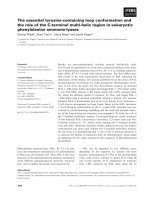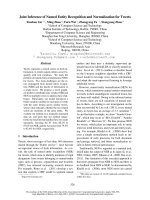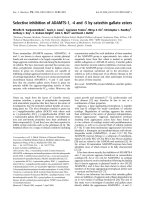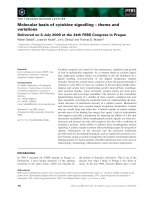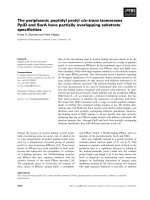Báo cáo khoa học: "The use of caspase inhibitors in pulsed-field gel electrophoresis may improve the estimation of radiation-induced DNA repair and apoptosis" pdf
Bạn đang xem bản rút gọn của tài liệu. Xem và tải ngay bản đầy đủ của tài liệu tại đây (1009.2 KB, 8 trang )
MET H O D O LO G Y Open Access
The use of caspase inhibitors in pulsed-field gel
electrophoresis may improve the estimation of
radiation-induced DNA repair and apoptosis
Josep Balart
1,5*
, Gemma Pueyo
1
, Lara I de Llobet
1
, Marta Baro
1
, Xavi Sole
2
, Susanna Marin
3
, Oriol Casanovas
1
,
Ricard Mesia
4
, Gabriel Capella
1
Abstract
Background: Radiation-induced DNA double-strand break (DSB) repair can be tested by using pulsed-field gel
electrophoresis (PFGE) in agarose-encapsulated cells. However, previous studies have reported that this assay is
impaired by the spontaneous DNA breakage in this medium. We investigated the mechanisms of this
fragmentation with the principal aim of eliminating it in order to improve the estimation of radiation-induced DNA
repair.
Methods: Samples from cancer cell cultures or xenografted tumours were encapsulated in agarose plugs. The cell
plugs were then irradiated, incubated to allow them to repair, and evaluated by PFGE, caspase-3, and histone
H2AX activation (gH2AX). In addition, apoptosis inhibition was evaluated through chemical caspase inhibitors.
Results: We confirmed that spon taneous DNA fragmentation was associated with the process of encapsulation,
regardless of whether cells were irradiated or not. This DNA fragmentation was also correlated to apoptosis
activation in a fraction of the cells encapsulated in agarose, while non-apoptotic cell fraction could rejoin DNA
fragments as was measured by gH2AX decrease and PFGE data. We were able to eliminate interference of
apoptosis by applying specific caspase inhibitors, and improve the estimation of DNA repair, and apoptosis itself.
Conclusions: The estimation of radiation-induced DNA repair by PFGE may be improved by the use of apoptosis
inhibitors. The ability to simultaneously determine DNA repair and apoptosis, which are involved in cell fate,
provides new insights for using the PFGE methodology as functional assay.
Background
The use of pulsed-field gel electrophoresis (PFGE) is
widespread in the evaluation of DNA fragmentation
caused by double-strand breaks (DSBs) following ioniz-
ing radiation [1-4]. The DNA-DSBs may result in the
formation of small (often acentric) chromosomal frag-
ments. Following this initial damage, cells activate DNA
repair mechanisms to prevent catastrophic mitosis and
cell death due to the loss of acentric DNA fragments
[5]. The principle of PFGE methodology is that t he
release of DNA from cells correlates adequately with the
intensity of DNA fragmentation [6]. The estimation of
DNA repair by PFGE is based on the diminution of
DNA released from cells as the length of the DNA frag-
ments increases through the process of rejoining. Thus,
a decrease in the ratio of DNA extracted from the cells
over a period of time can be used as an evaluation of
DNA repair [7].
In the PFGE technique, cells are encapsulate d in agar-
ose to form cell-plugs, thus preventing physic damage of
the cells while facilitating their manipulation and place-
ment into agarose gels where electrophoresis will take
place. Usually in laboratory routine, cells are encapsu-
lated after a period of repair which is allowed to occur
in physiological conditions such as either cell cultures
or xenografts. Thus, extraction ratios depend exclusively
on induced and repaired DNA damage. While the
desired strategy is to encapsulate cells after the period
* Correspondence:
1
Translational Research Laboratory - IDIBELL, Institut Català d’Oncologia,
L’Hospitalet de Llobregat, Spain
Full list of author information is available at the end of the article
Balart et al. Radiation Oncology 2011, 6:6
/>© 2011 Balart et al; licensee BioMed Central Ltd. This is an Open Access article distributed under the terms of the Creative Commons
Attribution Lic ense (http://creati vecommons.org/licenses/by/2.0), which permits unrestricted use, distribu tion, and reproduction in
any medium, provided the original work is properly cited.
of repair has finalized, in a clinical setting, where t he
availability of cells is limited by the small size of tumour
biopsies, it is crucial to concentrate cells in agarose
plugs– to obtain enough cell number for PFGE analysis
– before irradiati on [8]. However, this tactic means that
DNA breakage and repair occurs in a non-physiological
environment. Whitaker and McMillan reported in 1992
that encapsulating cells before irradiation impair the
estimation of DNA repair due to the interference of
spontaneous DNA fragmentation [8]. This pioneering
observation has been confirmed by other studies [9]
leading to the belief that results from these sorts of
studies (conditions) are not robust enough to properly
estimate DNA repair. Nevertheless, the underlying
mechanisms affecting cells embedded in agarose during
DNA repair in PFGE methodology are still not well
understood.
To better understand spontaneous DNA breakage–
whether cells are irradiated or not–while cells are
encapsulated, we decided to examine PFGE outcomes in
cell-plugs over a period of incubation. Our main find-
ings were that 1) incubation of agarose-encapsulated
cells induces DNA fragmentation, 2) spontaneous DNA
breakage is caused by apoptosis (which can be inhibited
by caspase inhibitors), and 3) reducing the interference
of spontaneous breakage improves our ability to esti-
mate DNA repair and to determine apoptosis intensity.
Methods
Cell lines and tumour xenografts
The tumour cells used in this study were human squa-
mouscarcinomaA431fromtheAmericanTypeCell
Collection (LGC Promochem, Barcelona, Spain), and
human pancreatic carcinoma NP18 cell line. NP18 cell
line was perpetuated in our laboratory as cell culture
and xenografts in nude mice [10,11]. Six-to-eight-week
old male athymic Swiss nu/nu mice (Harlan, Gannat,
France) were housed at our facilities (Association for
Assessment and Accreditat ion of Laboratory Animal
Care accreditation number 1155). Tumours were gener-
ated through subcutaneous cell injection of one million
NP18 cells into the flank of each mouse. All experimen-
tal procedures were approved in accordance with our
own institutional guidelines for animal care and ethics.
When tumours reached 10 mm in size, they were
excised, minced and incubated for 90 min in Dubelcco’s
Modified Eagle Medium (DMEM) (pH 7.4) containing
collagenase type IV (Sigma Aldrich Chemical, Saint
Louis, MO, US), and pronase E (Sigma). Then, cell sus-
pensions were incubated for 30 min in trypsin (Bio-
Whittaker, Verviers, Belgium), all a t 37°C in gentle
agitation. Cell suspensions were finally passed through a
70 μm nylon cell strainer (BD Falcon, Bedford, MA,
US).
DNA double-strand breaks assay for estimation of
rejoining using PFGE
Cell pellets obtained following monolayer harvesting or
solid tumour processing were mixed with 1% agarose
type VII (Sigma). Homogenous aliquots were pipetted
into 80 μL plug moulds (Bio-Rad, Hercules, CA, US) to
form cell-plugs, adjusting the number of cells per plug to
100,000 cells. Because the volume of the pellets from
tumours was slightly smaller than pellets from cell cul-
ture, we decided to form cell-plugs using the entire pellet
obtained after tumour disaggregation. Cell-plugs were
chilled at 4°C for 20 minutes, transferred to DMEM-filled
500 μL tubes, placed on ice, and irradiated at a dose rate
of 2.7 Gy/min (6 MV X-rays) up to 45 Gy, a common
dose level i n PFGE methodology [12-14]. Following irra-
diation, the medium was replaced with pre-incubated
medium at 37°C in a 5% CO
2
incubator. DNA Repair was
stopped by putting the cell-plugs on ice at 0, 0.5, 1, 2 or
4 h after irradiation. Sham uni rradiated cell-plugs w ere
managed in parallel with irradiated cell-plugs.
Before electrophoresis, cell-plugs were transferred into
ice-cold lysis buffer (pH 7.4) containing 2% sodium laur-
oyl-sarkosine (Fluka Chemie, Buchs, Switzerland), and
0.5 mg/mL proteinase-K (Sigma) in 0.5 M ethylenedia-
minetetraacetic acid (EDTA) (Sigma). Lysis was per-
formed on ice for 1 h and then at 37 °C for 24 h. At this
point, due to the fragility of agarose plugs, the corners
tended to break off easily. Therefore, to ensure that the
same number of cells (DNA) per lane was loaded into a
gel, we cut a section of the better preserved central area.
We created a specialized plug cutting device to obtain a
section measuring exactly 40 μ L. Gels were made of 1%
low-melting point agarose, type IX (Sigma), in 0.5 ×
Tris-Borate-EDTA buffer (TBE) (Sigma), pH 8 .4. DNA
fragments were resolved by PFGE (CHEF-DR-III, Bio-
Rad). Electric field strength was 1.6 V/cm with a switch-
ing pulse of 3,600 seconds, and a 115° reorientation field
angle [6]. PFGE was carried out in 0.5 × TBE buffer
chilled at 14°C for a total running time of 96 h. Sacchar-
omyces cervisiae and Schizosaccharomyces pombe yeast
chromosomes were used as DNA size markers
(Bio-Rad). Gels were stained overnight with 0.5 μg/mL
ethidium bromide, washed and transilluminated at
302 nm. Fluorescence intensity of the DNA was
acquired, and transfor med to arbitrary units of optical
density using a digital imaging analysis system ( GelDoc
2000 and Quantity One software, Bio -Rad). The sum of
fluorescence within DNA smears was used for calcula-
tions and assessing differences in between experiments.
Determination of H2AX and activated caspase-3 by
immunofluorescence
Cryostat sections (3-μm thick) of cell-plugs embedded in
Optimal Cutting Temperature OCT-compound (Sakura
Balart et al. Radiation Oncology 2011, 6:6
/>Page 2 of 8
Finetek Europe, Alphen aan Den Rijn, The Netherlands)
were used to determine h isto ne H2AX pho sphorylation
(gH2AX) or activation of apoptosis by cleavage of cas-
pase-3 [15,16]. Samples were fix ed with 4% neutral-
buffered formaldehyde, washed (0.1% triton in PBS for
10 min) and incubated for 1 hour with protein-blocking
solution. Next, the slides were incubated with primary
antibodies anti-phospho-histone H2AX (ser139) (Milli-
pore-Upstate, Billerica, MA, US) or cleaved caspase-3
(Asp175) (Cell Signaling Technology, Danvers, MA, US)
followed by incubation with secondary antibodies Alexa
Fluor 488-conjugated and Alexa Fluor 594-conjugated
(Invitrogen, Carlsbad, CA, US), respectively, all at a dilu-
tion of 1:500 for 1 h, at room temperature. Fluorescence
images were captured by using a Zeiss Axioplan 2 ima-
ging epi-fluorescence microscope equipped with a
charge-coupled device camera and SPOT advanced soft-
ware (Diagnostic Instruments Inc, Sterling Heights, MI,
US). Five to ten randomly selected field microscopic
images per slide were analyzed. Cells were counted
using the ImageJ program, public domain Java image
processing software ( />Activation of apoptosis in cells growing in monolayer
was examined using immunofluorescence by the specific
nuclear TO-PRO-3 dye (Invitrogen), cleaved caspase-3
(Asp175), and Alexa Fluor 488-conjugated antibodies.
Caspase inhibitors
To inhib it apoptosis, cell-plugs were treated with a pan-
caspase inhibitor, the halomethyl ketone z-vad-fmk
(Bachem, Bubendorf, Switzerland). Cells obtained from
xenografts were treated with the caspase-3 inhibitor
zvd-fmk (Bachem) instead of z-vad-fmk substance. Both
substances were incubated for 1 h before cell encapsula-
tion and during incubation at 10 μM and 100 μMcon-
centration, respectively.
Statistics
Results were expressed as mean ± standard error (SE).
Statistically significant differences in between-group
comparisons were defined by using a two-tailed signifi-
cance level of P < 0.05. The Statistical Package for Social
Sciences, version 13.0 (IBM, Madrid, Spain) was used
for data analysis.
Results
Irrespectively whether cells were irradiated or not, we
found that the pattern of DNA smears consisted of a
compression zone (CZ) just below the wells, which was
more patent in irradiated cells, followed with an area o f
distribution of DNA fragments ending in a sudden edge
(Figure 1). The GelDoc setting s for fluorescence acquisi-
tion were adjusted (exposuretimeandirisaperture)in
each gel to obtain smears below saturation levels but
sufficiently high to be measured. Thus, the range of fluor-
escence could vary depending on whether the gel con-
tained unirradiated or irradiated cell plugs. In
unirradiated cell-plu gs, we observed an initial low extrac-
tion of DNA which progressively increased over time.
In the A431 cell line, this spontaneous DNA fragmenta-
tion increased significantly over the incubation time
(Figure 1), and similar figures were seen in the NP18 cell
line (data not shown). In sharp contrast, in irradiated
cell-plugs the initial DNA extraction was higher than in
unirradiated cell-plugs i ndicating that radiation-induced
DNA breakage occurred in a manner quantifiable b y
PFGE. M oreover, in this irradiated plugs we found a
time-dependent decrease in DNA fragmentation compa-
tible with the process of rejoining (Figure 1). Although
some rejoining might have taken place in this experimen-
tal setting, proper estimation of DNA repair was clearly
interfered by spontaneous DNA fragmentation, logically
occurring in both unirradiated and irradiated cell-plugs.
Given that agarose is a non-physiological environment,
we hypothesized that spontaneous DNA degradation
Figure 1 PFGE pattern. (A) PFGE for a t ypical A431 cell line
experiment with agarose-encapsulated cells. The range of DNA
quantification, beginning just before the compression zone (CZ) and
ending at the bottom of the smears, is shown. (B) The amount of
released DNA (optical density, Arbitrary Units, AU) was plotted as a
function of time using the following time-points 0, 0.5, 1, 2 or 4 h.
U stands for unirradiated (black bars) and I for 45 Gy irradiated cell-
plugs (white bars). Data were obtained from one experiment.
Balart et al. Radiation Oncology 2011, 6:6
/>Page 3 of 8
observed in PFGE could be a consequence of apoptosis
triggered by agarose associated with the loss of normal
cell-matrix interactions. To evaluate this possibility we
examined apoptosis activation in cells embedded in
agarose. Thus, we decided to determine cleavaged
caspase-3 levels, an apopt osis effector, in cell-plugs
(Figure 2A). Cleavaged caspase-3 was gradually activated
regardless of whether the cells were irradiated or not,
suggesting that apoptosis was triggered by agarose envir-
onment (Figure 2B). To further confirm that the origin
of apoptosis was the encapsulation in agarose, we inves-
tigated the activation of caspase-3 in cells growing as
monolayer (in a physiological environment). We
observed only a minimal activation of apoptosis after 45
Gy (of 174 cells evaluated, 6 were caspase positive after
4 hours of incubation time: 3.44% of cell p opulation), a
finding that also precludes a substantial radiation-
induced origin of apoptosis and corroborates the partici-
pation of agarose in spontaneous DNA fragmentation
(Figure 3). To study whether apoptosis and repair could
coexist we determined simultaneously the activation of
caspase-3 and histone gH2AX by a double staining tech-
nique. Immediately following irradiation we observed
high levels of gH2AX induction and low levels o f clea-
vaged caspase-3 (Figure 2A). However, over incubation
time we found that a fraction of apoptotic cells was
simultaneously visible with a relevant fraction of cell s in
which the gH2AX was present (Figure 2A). As we were
able to exclude caspase-positive cells from gH2AX fluor-
escence measurements we could specifically determine
the evolution of DNA-DSBs. We found that initial radia-
tion-induced gH2AX fluorescence decreased significantly
over the incubation time, suggesting that in those cells
in which apoptosis was not triggered radiation-induced
damage could be repaired (F igure 2C). Interestingly,
while the intensity of gH2AX decreased in irradiated cell
plugs, the gH2AX levels in unirradi ated plugs did not
vary, indicating that gH2AX levels in those cells were
not significantly influenced by agarose (Figure 2C).
To further verify that the spontaneous DNA fragmen-
tation observed in the PGFE experiments was induced
by apoptosis, we treated cell-plugs with the pancaspase
inhibitor z-vad-fmk. First, we corroborated that merely
incubating cell-plugs was sufficient to induce DNA frag-
mentation in a time-dependent manner (Figure 4). W e
next found that treatment of these cell-plugs with the
anti-apoptotic agent inhibited progressive spontaneous
DNA degradation, confirming the crucial role of apopto-
sis and corroborating the mechanistic explanation of the
caspase-3 activation we demonstrated by immunofluor-
escence method in cell-plugs (Figure 4).
Since encapsulatin g cells before irra diation is par ticu-
larly useful in a clinical setting with tumour biopsies, our
aim was to investigate whether the inhibition of apoptosis
would facilitate the evaluation DNA repair in this con-
text. To do this, we removed tumo urs (<1000 mm
3
)
derived from NP18 cells from the subcutaneous tissue of
nude mice. In plugs containing cells from xenografts we
reproduced the DNA fragmentation pattern previously
observed in PFGE of cultured cells(showninFigure1).
In irradiated cell-plugs, radiation-induced DNA-DSB
decreased progressively, whereas spontaneous fragmenta-
tion increased gradually (Figure 5). However, when cell-
plugs were treated with zvd-fmk, a specific caspase-3
inhibitor, spontaneous DNA deg radation was inhibited
ove r the entire time-course (P > 0.3). Importantly, radia-
tion induced DNA breakage, which is attributable to
rejoining, continued diminishing (Figure 5). The blockade
of apopto sis thus allo wed us to efficiently determine
rejoining witho ut the inference of the apoptosis. Figure 5
illustrates the effect of abrogating apoptosis in NP18 cells
from a xenograft, showing clear differences between
initial and residual radiat ion-induced damage depending
on the absence or presence of zvd-fmk. By inhibiting
apoptosis, we were able to reduce spontaneous DNA
breakage and estimate rejoining as the initial DNA
released minus residual DNA re leased without the inter-
ference of apoptosis. On the other hand, the intensity of
apoptosis could be easily estimated by subtracting the
total DNA released in unirrad iated zvd-treated cel l-plugs
from the unirradiated non-zvd-treated cell-plugs.
Discussion
It is believed that specific tumour radiosensitivity is
highly dependent on DNA repair and, reasonably,
tumour response is also influenced by this biologic vari-
able. Initially, PFGE was devised as a test for predicting
cancer response to radiation therapy. However, soon
thereafter the few studies that examined the utility of
the PFGE method in tumour biopsies concluded that
PFGE was insufficiently robust to be a predictive test,
mainly due to spontaneous DNA fragmentation that
occurs during sample processing. In the present study,
we revisited the PFGE method to demonstrate that
apoptosis induced by agarose is a component of total
DNA breakage, and that the inhibition of apoptosis
allows for more proper estimation of radiation-induced
DNA DSB repair and apoptosis itself. First, we found
spontaneous cleavage of caspase-3 in the cell-plugs, sug-
gesting that the agarose environment triggered apoptosis
activation, and second we inhibited spontaneous DNA
fragmentation in PFGE by means of selective and speci-
fic caspase inhib itors . This is the first study t o describe
that the spontaneously released DNA in cell-plugs
reflects an ongoing homeless-induced apoptosis, referred
to as anoikis [17], when cells are embedded in agarose.
DNA cleavage into large fragments is an early event
observed in the apoptotic cascade before the typical
Balart et al. Radiation Oncology 2011, 6:6
/>Page 4 of 8
endonuclease cleavage into 180 to 200 bp can be
detected as a DNA ladder [18]. This DNA breakage is
exactly what we observed in our experiments, and
further supports the apoptotic aetiology of spontaneous
degradation. Furthermore, the fact that we did not
detect caspase-3 activation in irradiated cells growing as
a monolayer, and caspase-3 activation was seen only in
cells embedded in agarose (whether irradiated or not),
allows us to rule out a radiation-induced origin of
apoptosis.
After elucidating the m echanism behind DNA degra-
dation, it seemed reasonable to conclude that apoptosis
initiation was occurring in both unirradiated and irra-
diated cell-plugs. However, our findings show that
gH2AX fluorescence, a surrogate marker of DNA-DSB
[19], continued to decrease progressively, a result
Figure 2 Caspase-3 activation increased and radiation-induced gH2AX fluorescence decreased in a time-dependent manner. (A) NP18
cell-plugs were irradiated with 45 Gy and incubated to allow for 0, 1, 2 or 4 h of repair. Illustrative DAPI stained nuclei (blue), fluorescence from
caspase-activated cells (red), and gH2AX fluorescence (green) pictures are shown at 0 and 4 hours incubation times. Regions of interest (ROI) are
depicted (original magnification, ×1000). (B) NP18 cell-plugs were irradiated (white bars) or not (black bars) and anoikis (% of cells showing
activated caspase in 100 cells counted per time point) were determined. (C) In the same cells as in panel B, gH2X fluorescence (within DAPI-ROI
in 150 nuclei counted per time point) was measured in caspase-negative cells. Data were obtained from 2 independent experiments. P-values
were calculated using the Mann-Whitney test.
Balart et al. Radiation Oncology 2011, 6:6
/>Page 5 of 8
compatible with radiation-induced DNA-DSB repair. We
should keep in mind that during incubation, apoptosis
activation was triggered in a percentage of cells, whereas
in non-apoptotic cells repair took place, as we were able
to show by eliminating apoptotic cells from the quantifi-
cation of fluorescence in cell-plugs. Thus, in our PFGE
we obtained smears that represent the final stage of two
independent processes–DNA repair and anoikis–at each
time point.
This type of apoptosis is physiologically induced to
prevent proliferation of cells at inappropriate locations.
Tumour cells that lose this homeostatic control can
manage to thrive in an anchorage-indep endent manner,
an aggressive characteristic of different types of human
malignancies. The clinical significance of resistance to
anoi kis is increa singly associated with malignant pheno-
types, therapy resistance, and poor prognosis [20].
Finally, by incubating cell plugs in absence or presence
of caspase inhibitors we were able to determine two
traits associated with tumour aggressiveness, DNA
repair and apoptosis. Reasonably, in a short time-course
scheme, a relatively low DNA release rate will indicate
an aggressive phenotype because the majority of radia-
tion-induced DNA fragments are quickly rejoined
Figure 3 Apoptosis in irradiated cells growing as monolayer was negligible. NP18 cells growing on glass coverslip were irradiated with 45
Gy and incubated for 4 hours. Shown are five microscopic pictures (original magnification, ×1000): TO-PRO-3 stained nuclei (red), fluorescence
from caspase-3-activated cells (green), and merged pictures. In sharp contrast with Figure 2B, apoptosis was negligible. Despite irradiation, the
typical nuclear fragmentation and chromatin condensation associated with apoptosis was minimal, but consistent with the specific activation of
caspase-3.
Figure 4 Caspase inhibitors blocked apoptosis induced by
agarose encapsulation. Representative PFGE from A431 and NP18
cell lines are depicted. Spontaneous DNA fragmentation induced
exclusively by incubation in unirradiated cell-plugs (black bars) was
inhibited (grey bars) by zvad-fmk (100 μM). *P = 0.016; **P = 0.083
(Mann-Whitney test, 4 independent experiments). No significant
differences were found between the A431 and N18 cell lines.
Balart et al. Radiation Oncology 2011, 6:6
/>Page 6 of 8
(resistance to radiation) and apoptosis is not triggered
(resistance to apoptosis). In this scenario, cancer cells
would survive in an adverse environment (i.e., loss of
extracellular matrix due to radiation cell killing) and
would rapidly recover their proliferative potential. On
the other hand, a significant smear would indicate a less
aggressive behaviour due to low radiation repair and
high sensitivity to anoikis.
Conclusions
Our study confirms previous findings that apoptosis
occurring in agarose-encapsulated cells interferes with
PFGE evaluation of radiation-induced DNA repair analy-
sis. However, we found that it is possible to reduce this
interference by using caspase inhibitors, thereby greatly
improving the estimation of DNA repair in tumour
cells. Simultaneously, apoptosis induced by agarose can
also be determined. The ability to determine together
two traits–repair and apoptosis–involved in cell fate
opens new possibilities for PFGE as functional assay.
Acknowledgements
The authors would like to acknowledge the contribution of the Pla Director
d’Oncologia to the initial set up of the Program of Applied Radiobiology of
Catalonia (PRACAT), and to thank the financial support of the Spanish
Association Against Cancer. We are grateful to Bradley J Londres for his
excellent assistance in improving the English in the manuscript.
Author details
1
Translational Research Laboratory - IDIBELL, Institut Català d’Oncologia,
L’Hospitalet de Llobregat, Spain.
2
Biostatistics & Bioinformatics Unit,
Department of Epidemiology and Cancer Registry, Institut Català
d’Oncologia, L’Hospitalet de Llobregat, Spain.
3
Department of Radiation
Oncology, Institut Català d’Oncologia, L’Hospitalet de Llobregat, Spain.
4
Department of Medical Oncology, Institut Català d’Oncologia, L’Hospitalet
de Llobregat, Spain.
5
Department of Radiation Oncology, Hospital de la
Santa Creu i Sant Pau, Barcelona, Spain.
Authors’ contributions
JB conceived the study and drafted the manuscript. GP, LL and MB
participated in PFGE and in immunofluorescence studies. XS provided
informatics and support with statistics for data analysis. SM, OC, RM and GC
participated importantly in the conception, design of the study and helped
to draft the manuscript. All authors read and approved the final manuscript.
Competing interests
The authors declare that they have no competing interests.
Received: 5 August 2010 Accepted: 15 January 2011
Published: 15 January 2011
References
1. Blocher D, Einspenner M, Zajackowski J: CHEF electrophoresis, a sensitive
technique for the determination of DNA double-strand breaks.
International journal of radiation biology 1989, 56:437-448.
2. McMillan TJ, Tobi S, Mateos S, Lemon C: The use of DNA double-strand
break quantification in radiotherapy. Int J Radiat Oncol Biol Phys 2001,
49:373-377.
3. Iliakis G, Cheong N: In vitro rejoining of double-strand breaks in genomic
DNA. Methods Mol Biol 2006, 314:95-108.
4. Jensen A, Debus J, Weber KJ: S-phase cell-specific modification by
gemcitabine of PFGE-analyzed radiation-induced DNA fragmentation
and rejoining. International journal of radiation biology 2008,
84:770-777.
5. Bedford JS: Sublethal damage, potentially lethal damage, and
chromosomal aberrations in mammalian cells exposed to ionizing
radiations. Int J Radiat Oncol Biol Phys 1991, 21:1457-1469.
6. Kuhne M, Riballo E, Rief N, Rothkamm K, Jeggo PA, Lobrich M: A double-
strand break repair defect in ATM-deficient cells contributes to
radiosensitivity. Cancer research 2004, 64:500-508.
7. Nunez MI, Villalobos M, Olea N, Valenzuela MT, Pedraza V, McMillan TJ, Ruiz
de Almodovar JM: Radiation-induced DNA double-strand break rejoining
in human tumour cells. Br J Cancer 1995, 71:311-316.
8. Whitaker SJ, McMillan TJ: Pulsed-field gel electrophoresis in the
measurement of DNA double-strand break repair in xrs-6 and CHO cell
lines: DNA degradation under some conditions interferes with the
assessment of double-strand break rejoining. Radiat Res 1992,
130:389-392.
9. van Waarde MA, van Assen AJ, Konings AW, Kampinga HH: Feasibility of
measuring radiation-induced DNA double strand breaks and their repair
by pulsed field gel electrophoresis in freshly isolated cells from the
mouse RIF-1 tumor. International Journal of Radiation Oncology, Biology,
Physics 1996, 36:125-134.
10. Villanueva A, Garcia C, Paules AB, Vicente M, Megias M, Reyes G, de
Villalonga P, Agell N, Lluis F, Bachs O, Capella G: Disruption of the
antiproliferative TGF-beta signaling pathways in human pancreatic
cancer cells. Oncogene 1998, 17:1969-1978.
11. Martinez-Quintanilla J, Cascallo M, Gros A, Fillat C, Alemany R: Positive
selection of gene-modified cells increases the efficacy of pancreatic
cancer suicide gene therapy. Molecular cancer therapeutics 2009,
8:3098-3107.
12. DiBiase SJ, Zeng ZC, Chen R, Hyslop T, Curran WJ Jr, Iliakis G: DNA-
dependent protein kinase stimulates an independently active,
nonhomologous, end-joining apparatus. Cancer research 2000,
60:1245-1253.
Figure 5 Red uction of apoptosis improv ed the estimation of
DNA repair in NP18 xenografts. PFGE was performed in
unirradiated (black bars) and irradiated (45 Gy; white bars) cell-plugs
obtained from xenografts (NP18) incubated in absence or presence
of zvd-fmk (10 μM). Optical density was normalized to radiation-
induced initial damage in absence of, or presence of zvd-fmk. In
absence of zvd-fmk, spontaneous DNA fragmentation (black bars)
increased significantly while radiation-induced breakage (white bars)
decreased over time-course. In presence of zvd-fmk, radiation-
induced fragmentation decreased but spontaneous DNA breakage
was blocked. *P < 0.05 compared to optical density at time 0 h
(Mann-Whitney test, 4 independent experiments).
Balart et al. Radiation Oncology 2011, 6:6
/>Page 7 of 8
13. Dickson J, Magee B, Stewart A, West CM: Relationship between residual
radiation-induced DNA double-strand breaks in cultured fibroblasts and
late radiation reactions: a comparison of training and validation cohorts
of breast cancer patients. Radiotherapy & Oncology 2002, 62:321-326.
14. Nunez MI, Guerrero MR, Lopez E, del Moral MR, Valenzuela MT, Siles E,
Villalobos M, Pedraza V, Peacock JH, Ruiz de Almodovar JM: DNA damage
and prediction of radiation response in lymphocytes and epidermal skin
human cells. Int J Cancer 1998, 76:354-361.
15. Mahrhofer H, Burger S, Oppitz U, Flentje M, Djuzenova CS: Radiation
induced DNA damage and damage repair in human tumor and
fibroblast cell lines assessed by histone H2AX phosphorylation. Int J
Radiat Oncol Biol Phys 2006, 64:573-580.
16. Debnath J, Muthuswamy SK, Brugge JS: Morphogenesis and oncogenesis
of MCF-10A mammary epithelial acini grown in three-dimensional
basement membrane cultures. Methods (San Diego, Calif 2003, 30:256-268.
17. Frisch SM, Screaton RA: Anoikis mechanisms. Curr Opin Cell Biol 2001,
13:555-562.
18. Brown DG, Sun XM, Cohen GM: Dexamethasone-induced apoptosis
involves cleavage of DNA to large fragments prior to internucleosomal
fragmentation. The Journal of biological chemistry 1993, 268:3037-3039.
19. Bonner WM, Redon CE, Dickey JS, Nakamura AJ, Sedelnikova OA, Solier S,
Pommier Y: GammaH2AX and cancer. Nature reviews 2008, 8:957-967.
20. Liotta LA, Kohn E: Anoikis: cancer and the homeless cell. Nature 2004,
430:973-974.
doi:10.1186/1748-717X-6-6
Cite this article as: Balart et al.: The use of caspase inhibitors in pulsed-
field gel electrophoresis may improve the estimation of radiation-
induced DNA repair and apoptosis. Radiation Oncology 2011 6:6.
Submit your next manuscript to BioMed Central
and take full advantage of:
• Convenient online submission
• Thorough peer review
• No space constraints or color figure charges
• Immediate publication on acceptance
• Inclusion in PubMed, CAS, Scopus and Google Scholar
• Research which is freely available for redistribution
Submit your manuscript at
www.biomedcentral.com/submit
Balart et al. Radiation Oncology 2011, 6:6
/>Page 8 of 8
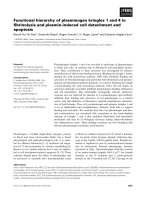
![Tài liệu Báo cáo khoa học: Specific targeting of a DNA-alkylating reagent to mitochondria Synthesis and characterization of [4-((11aS)-7-methoxy-1,2,3,11a-tetrahydro-5H-pyrrolo[2,1-c][1,4]benzodiazepin-5-on-8-oxy)butyl]-triphenylphosphonium iodide doc](https://media.store123doc.com/images/document/14/br/vp/medium_vpv1392870032.jpg)

